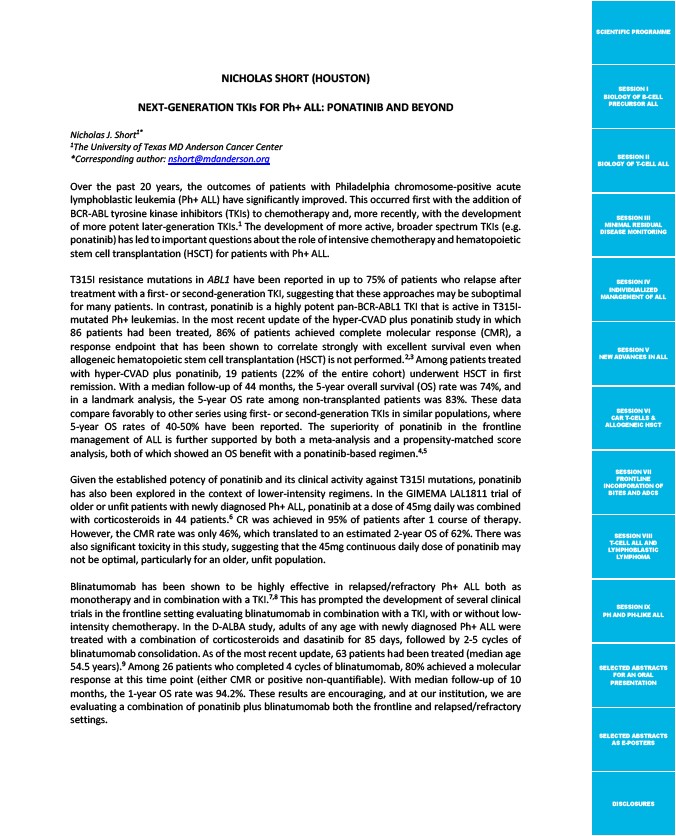
SCIENTIFIC PROGRAMME
SESSION I
BIOLOGY OF B-CELL
PRECURSOR ALL
SESSION II
BIOLOGY OF T-CELL ALL
SESSION III
MINIMAL RESIDUAL
DISEASE MONITORING
SESSION IV
INDIVIDUALIZED
MANAGEMENT OF ALL
SESSION V
NEW ADVANCES IN ALL
SESSION VI
CAR T-CELLS &
ALLOGENEIC HSCT
SESSION VII
FRONTLINE
INCORPORATION OF
BITES AND ADCS
SESSION VIII
T-CELL ALL AND
LYMPHOBLASTIC
LYMPHOMA
SESSION IX
PH AND PH-LIKE ALL
SELECTED ABSTRACTS
FOR AN ORAL
PRESENTATION
SELECTED ABSTRACTS
AS E-POSTERS
DISCLOSURES
NICHOLAS SHORT (HOUSTON)
NEXT-GENERATION TKIs FOR Ph+ ALL: PONATINIB AND BEYOND
Nicholas J. Short1*
1The University of Texas MD Anderson Cancer Center
*Corresponding author: nshort@mdanderson.org
Over the past 20 years, the outcomes of patients with Philadelphia chromosome-positive acute
lymphoblastic leukemia (Ph+ ALL) have significantly improved. This occurred first with the addition of
BCR-ABL tyrosine kinase inhibitors (TKIs) to chemotherapy and, more recently, with the development
of more potent later-generation TKIs.1 The development of more active, broader spectrum TKIs (e.g.
ponatinib) has led to important questions about the role of intensive chemotherapy and hematopoietic
stem cell transplantation (HSCT) for patients with Ph+ ALL.
T315I resistance mutations in ABL1 have been reported in up to 75% of patients who relapse after
treatment with a first- or second-generation TKI, suggesting that these approaches may be suboptimal
for many patients. In contrast, ponatinib is a highly potent pan-BCR-ABL1 TKI that is active in T315I-mutated
Ph+ leukemias. In the most recent update of the hyper-CVAD plus ponatinib study in which
86 patients had been treated, 86% of patients achieved complete molecular response (CMR), a
response endpoint that has been shown to correlate strongly with excellent survival even when
allogeneic hematopoietic stem cell transplantation (HSCT) is not performed.2,3 Among patients treated
with hyper-CVAD plus ponatinib, 19 patients (22% of the entire cohort) underwent HSCT in first
remission. With a median follow-up of 44 months, the 5-year overall survival (OS) rate was 74%, and
in a landmark analysis, the 5-year OS rate among non-transplanted patients was 83%. These data
compare favorably to other series using first- or second-generation TKIs in similar populations, where
5-year OS rates of 40-50% have been reported. The superiority of ponatinib in the frontline
management of ALL is further supported by both a meta-analysis and a propensity-matched score
analysis, both of which showed an OS benefit with a ponatinib-based regimen.4,5
Given the established potency of ponatinib and its clinical activity against T315I mutations, ponatinib
has also been explored in the context of lower-intensity regimens. In the GIMEMA LAL1811 trial of
older or unfit patients with newly diagnosed Ph+ ALL, ponatinib at a dose of 45mg daily was combined
with corticosteroids in 44 patients.6 CR was achieved in 95% of patients after 1 course of therapy.
However, the CMR rate was only 46%, which translated to an estimated 2-year OS of 62%. There was
also significant toxicity in this study, suggesting that the 45mg continuous daily dose of ponatinib may
not be optimal, particularly for an older, unfit population.
Blinatumomab has been shown to be highly effective in relapsed/refractory Ph+ ALL both as
monotherapy and in combination with a TKI.7,8 This has prompted the development of several clinical
trials in the frontline setting evaluating blinatumomab in combination with a TKI, with or without low-intensity
chemotherapy. In the D-ALBA study, adults of any age with newly diagnosed Ph+ ALL were
treated with a combination of corticosteroids and dasatinib for 85 days, followed by 2-5 cycles of
blinatumomab consolidation. As of the most recent update, 63 patients had been treated (median age
54.5 years).9 Among 26 patients who completed 4 cycles of blinatumomab, 80% achieved a molecular
response at this time point (either CMR or positive non-quantifiable). With median follow-up of 10
months, the 1-year OS rate was 94.2%. These results are encouraging, and at our institution, we are
evaluating a combination of ponatinib plus blinatumomab both the frontline and relapsed/refractory
settings.